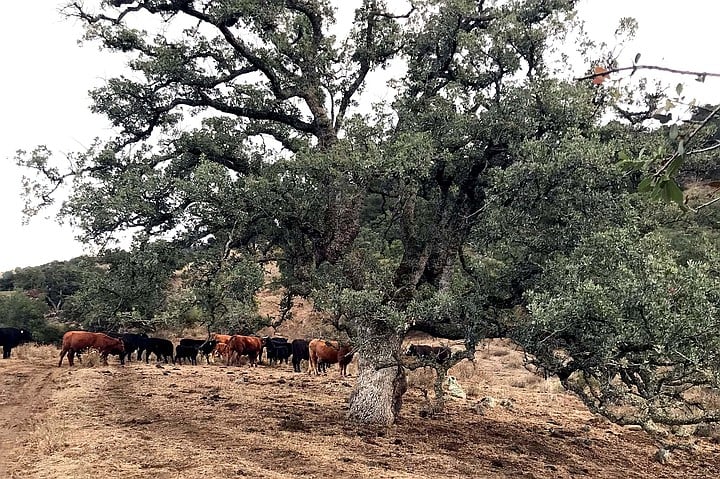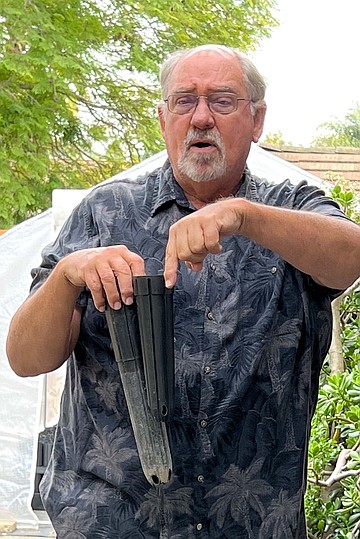 Facebook
Facebook
 X
X
 Instagram
Instagram
 TikTok
TikTok
 Youtube
Youtube

It’s the rarest oak species in the U.S., it’s endangered, and 93 percent live right here in San Diego. In the 1840s German doctor George Engelmann, studying plants along the U.S.-Mexico border, noticed some distinctions in oaks he saw growing only in the foothills: they had stubbier, browner acorns and smooth-edged, grayish-tinted leaves, not the jagged green of the more widely distributed coast live oak. And the branches of these mid-elevation oaks, others noted, formed more complex and twisted canopies. Botanists later officially named the Engelmann oak, which indigenous inhabitants already knew as a prodigious sweet acorn producer. A storied grove of over 400 Engelmann oaks just north of Escondido named La Huerta by the Spanish was a summer acorn-gathering place until the trees were cut down to make way for citrus in the late 1880s.
In 2023 the relatively few Engelmann oaks scattered around the foothills of San Diego County had a “mast” year: each tree produced thousands of acorns. Before the acorns got squirreled away or had time to rot on the ground (which most do, only a few will sprout) retired Valley Center Middle School teacher Jim Crouch sprang into action. He distributed flyers in a few neighborhoods, near his Escondido home, where magnificent Engelmanns grow—like Treeside Drive in Hidden Meadows—saying roughly, “Hey, I like your oaks, can I collect your acorns?” After a few years collecting and sprouting other types of oaks, he had a pretty good idea where to look.

Wielding buckets and the good grace of homeowners to enter private property, Crouch and a few volunteers hurried to collect thousands of Engelmann acorns from Escondido, Ramona, and a cattle ranch in Santa Ysabel. 300 came from Santa Ysabel Open Space Preserve, where Engelmanns overhang the parking lot. Crouch is now sprouting and distributing the precious seedlings—with healthy tap roots—to folks with enough room to plant them, at the right elevations.
Engelmann oaks have a very limited range: from northern Baja to southern Los Angeles County, and only at elevations from 1200’-4200’. The U.S. Forest Service reported that significant stands survive at Camp Pendleton and on the Santa Rosa Plateau near Murrieta, and there’s a historic grove at L.A. Botanical Garden. Daley Ranch has an Engelmann Oak trail. Crouch said Engelmanns survive on reservations in San Diego County, such as La Jolla Indian Reservation, which happen to be at the right elevation. Development has encroached on most of the tree’s habitat—the low foothills and mesas where the trees thrive are ideal for homebuilding. Crouch has heard there’s a big stand north of I-210 in LA County; indeed, the tree is also known as Pasadena oak.
Another Engelmann distinction: it’s impervious to the gold-spotted oak borer, which spreads a fungus that has killed scores of coast live oaks in San Diego County and beyond. Crouch uses that as a “selling point” when convincing homeowners and land keepers to plant Engelmanns—though the polyphagous shot hole borer, which does affect Engelmanns, has recently been detected in San Diego.

Crouch does this work “for his grandkids,” he said. Oaks are a keystone species: they support more life forms than any other North American tree genus. When he started, he didn’t know much about his predecessor, the Oak Lady of Escondido, who was born in 1901 and lived next to a huge old Engelmann oak most of her life. She called the tree Quella. Frances Ryan worked to preserve Engelmanns in San Diego County—though, she told Gordon Smith at the Reader in 1986, it was her father, before she was born, who cut down the 400 at La Huerta to make way for his boss’s new orchard.
Ryan planted Engelmann seedlings around her family home, near La Huerta, and throughout the hills of North County. In 1989 a wildfire claimed many of the old oaks on her property, after the University of California reneged on a promise to create an Engelmann oak preserve there. Quella survived the fire. Frances Ryan died in 1990. Crouch’s granddaughter plays soccer at the Escondido park named after her—”it has great old oaks,” he said, “but sadly no Engelmanns.”
Crouch has about 2500 Engelmann acorns this year. He estimates about 50 percent will sprout, in his backyard in rows of narrow, conical tree pots, lovingly watered with rainwater he collects. He’s pretty sure they will all find homes. Volcan Mountain preserve might take up to 1000, and through Facebook and other connections he has developed a long list of home- and landowners willing to plant in Julian, Escondido, Ramona, San Marcos, Vista, Descanso, Jamul, La Cresta, and more. A friend at Pala, who Crouch said “plants carefully” and enlists neighbors to water when he travels, asked for 100. Requirements for adoption: a large tract of land at 1200’-4200’ and irrigation for two years while the sapling gets established. Plant in January for lower elevations, near the spring equinox for higher country. Engelmanns can survive drought, but it’s not clear how climate change is affecting the species. The San Diego Zoo and Wildlife Alliance cryogenically preserved DNA from Engelmann seedlings Crouch sprouted. Contact [email protected].


It’s the rarest oak species in the U.S., it’s endangered, and 93 percent live right here in San Diego. In the 1840s German doctor George Engelmann, studying plants along the U.S.-Mexico border, noticed some distinctions in oaks he saw growing only in the foothills: they had stubbier, browner acorns and smooth-edged, grayish-tinted leaves, not the jagged green of the more widely distributed coast live oak. And the branches of these mid-elevation oaks, others noted, formed more complex and twisted canopies. Botanists later officially named the Engelmann oak, which indigenous inhabitants already knew as a prodigious sweet acorn producer. A storied grove of over 400 Engelmann oaks just north of Escondido named La Huerta by the Spanish was a summer acorn-gathering place until the trees were cut down to make way for citrus in the late 1880s.
In 2023 the relatively few Engelmann oaks scattered around the foothills of San Diego County had a “mast” year: each tree produced thousands of acorns. Before the acorns got squirreled away or had time to rot on the ground (which most do, only a few will sprout) retired Valley Center Middle School teacher Jim Crouch sprang into action. He distributed flyers in a few neighborhoods, near his Escondido home, where magnificent Engelmanns grow—like Treeside Drive in Hidden Meadows—saying roughly, “Hey, I like your oaks, can I collect your acorns?” After a few years collecting and sprouting other types of oaks, he had a pretty good idea where to look.

Wielding buckets and the good grace of homeowners to enter private property, Crouch and a few volunteers hurried to collect thousands of Engelmann acorns from Escondido, Ramona, and a cattle ranch in Santa Ysabel. 300 came from Santa Ysabel Open Space Preserve, where Engelmanns overhang the parking lot. Crouch is now sprouting and distributing the precious seedlings—with healthy tap roots—to folks with enough room to plant them, at the right elevations.
Engelmann oaks have a very limited range: from northern Baja to southern Los Angeles County, and only at elevations from 1200’-4200’. The U.S. Forest Service reported that significant stands survive at Camp Pendleton and on the Santa Rosa Plateau near Murrieta, and there’s a historic grove at L.A. Botanical Garden. Daley Ranch has an Engelmann Oak trail. Crouch said Engelmanns survive on reservations in San Diego County, such as La Jolla Indian Reservation, which happen to be at the right elevation. Development has encroached on most of the tree’s habitat—the low foothills and mesas where the trees thrive are ideal for homebuilding. Crouch has heard there’s a big stand north of I-210 in LA County; indeed, the tree is also known as Pasadena oak.
Another Engelmann distinction: it’s impervious to the gold-spotted oak borer, which spreads a fungus that has killed scores of coast live oaks in San Diego County and beyond. Crouch uses that as a “selling point” when convincing homeowners and land keepers to plant Engelmanns—though the polyphagous shot hole borer, which does affect Engelmanns, has recently been detected in San Diego.

Crouch does this work “for his grandkids,” he said. Oaks are a keystone species: they support more life forms than any other North American tree genus. When he started, he didn’t know much about his predecessor, the Oak Lady of Escondido, who was born in 1901 and lived next to a huge old Engelmann oak most of her life. She called the tree Quella. Frances Ryan worked to preserve Engelmanns in San Diego County—though, she told Gordon Smith at the Reader in 1986, it was her father, before she was born, who cut down the 400 at La Huerta to make way for his boss’s new orchard.
Ryan planted Engelmann seedlings around her family home, near La Huerta, and throughout the hills of North County. In 1989 a wildfire claimed many of the old oaks on her property, after the University of California reneged on a promise to create an Engelmann oak preserve there. Quella survived the fire. Frances Ryan died in 1990. Crouch’s granddaughter plays soccer at the Escondido park named after her—”it has great old oaks,” he said, “but sadly no Engelmanns.”
Crouch has about 2500 Engelmann acorns this year. He estimates about 50 percent will sprout, in his backyard in rows of narrow, conical tree pots, lovingly watered with rainwater he collects. He’s pretty sure they will all find homes. Volcan Mountain preserve might take up to 1000, and through Facebook and other connections he has developed a long list of home- and landowners willing to plant in Julian, Escondido, Ramona, San Marcos, Vista, Descanso, Jamul, La Cresta, and more. A friend at Pala, who Crouch said “plants carefully” and enlists neighbors to water when he travels, asked for 100. Requirements for adoption: a large tract of land at 1200’-4200’ and irrigation for two years while the sapling gets established. Plant in January for lower elevations, near the spring equinox for higher country. Engelmanns can survive drought, but it’s not clear how climate change is affecting the species. The San Diego Zoo and Wildlife Alliance cryogenically preserved DNA from Engelmann seedlings Crouch sprouted. Contact [email protected].
Comments